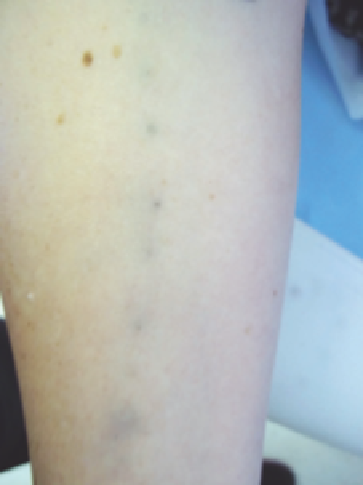Biomedical Engineering Reference
In-Depth Information
(
A
)
(
B
)
Figure 4.12
Traumatic tattoo before and traumatic tattoo after. (
A
) Traumatic tattoo at the Cupid's bow secondary to a fall on asphalt; (
B
) signifi cant ink resolution
8 weeks after a single treatment with a neodymium-doped:yttrium-aluminum-garnet laser.
Figure 4.14
Lip. Orolabial mucosal tattoo.
Figure 4.13
Track marks. Unintentional track mark tattoos in a former
intravenous heroin user.
warranted as a henna tattoo will gradually fade away over the
course of a few days to weeks as the skin naturally sloughs off.
future developments in tattoo removal
Although Q-switched lasers provide a dramatic improvement
over previous tattoo removal modalities and are now consid-
ered the “gold standard” treatment option, it is possible that we
will see even more effi cient removal techniques in the future.
Some dermatologists are beginning to combine Q-switched
laser technology with fractional resurfacing in hopes of
increasing ink clearance (261). Additionally, the exploration of
picosecond (10
−12
) lasers has begun (262). Theoretically, this
would allow for more effective treatment utilizing lower fl u-
ences, thereby decreasing thermal energy transfer to surround-
ing tissues and minimizing the risk of adverse events, including
tissue texture changes, scarring, and discoloration. The possi-
bility of the use of femtosecond (10
−15
) technology to treat tat-
toos exists in theory as well, but the viability of its practical
application on a wide scale is yet to be determined.
Changes to current treatment protocols using existing tech-
nology could theoretically provide faster ink resolution.
A small study on 12 patients in Greece was performed using a
single Q-switched laser with four treatment passes separated
by 20 minutes (263). The authors of this “R20” method
noted that this treatment protocol was more effective than
conventional laser treatment with the same incidence of side
Q-switched lasers or punch biopsies. Many cancer survivors
feel that these tattoos are a sign of strength and survival and
may choose to forgo tattoo removal treatment.
Fluorescent Tattoos
Rarely a patient will present with a tattoo composed of pig-
ment that is invisible in normal light but becomes observable
with exposure to black light or a Wood's lamp. Patients refer to
these tattoos as “fl uorescent” tattoos, but they are also known
as “glow-in-the-dark” or “ultraviolet (UV)” tattoos. Because
the photoluminescent ingredient in many of these tattoos is
unknown and since this ink is often not responsive to
Q-switched laser treatment, the safest removal option for these
tattoos, if possible, is often surgical excision.
Henna Tattoos
Coming from a south Asian tradition that has now become
common at many tropical vacation destinations, henna tattoos
are a form of a temporary tattoo that uses a dye made from the
leaves of the henna plant,
Lawsonia inermis
. After being
painted on and left to dry, a paste made from the powdered
leaves of the plant binds with keratin in skin. No treatment is


















